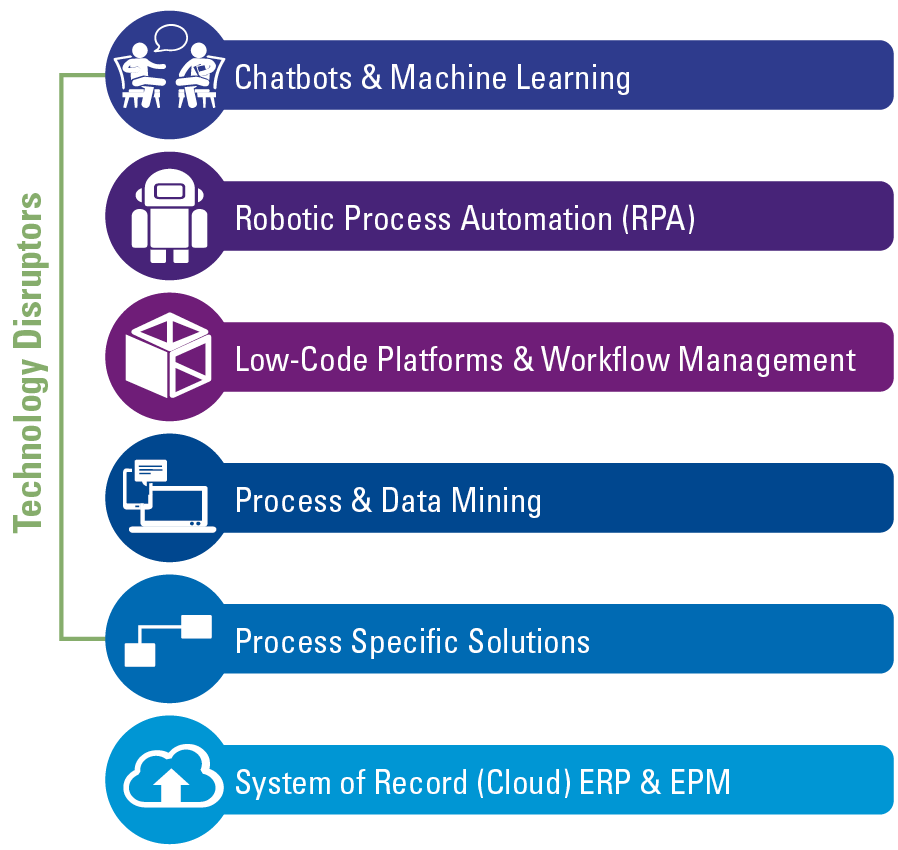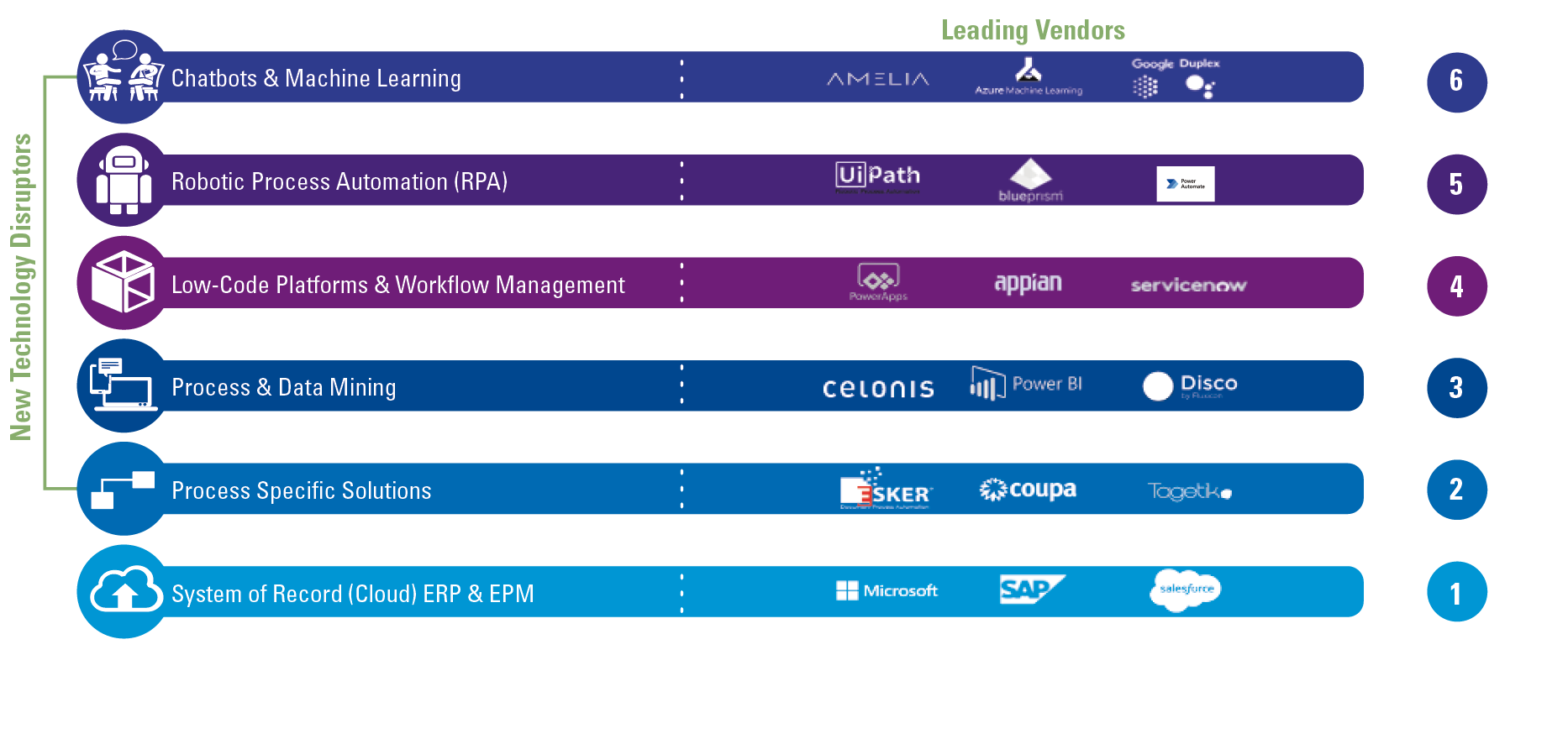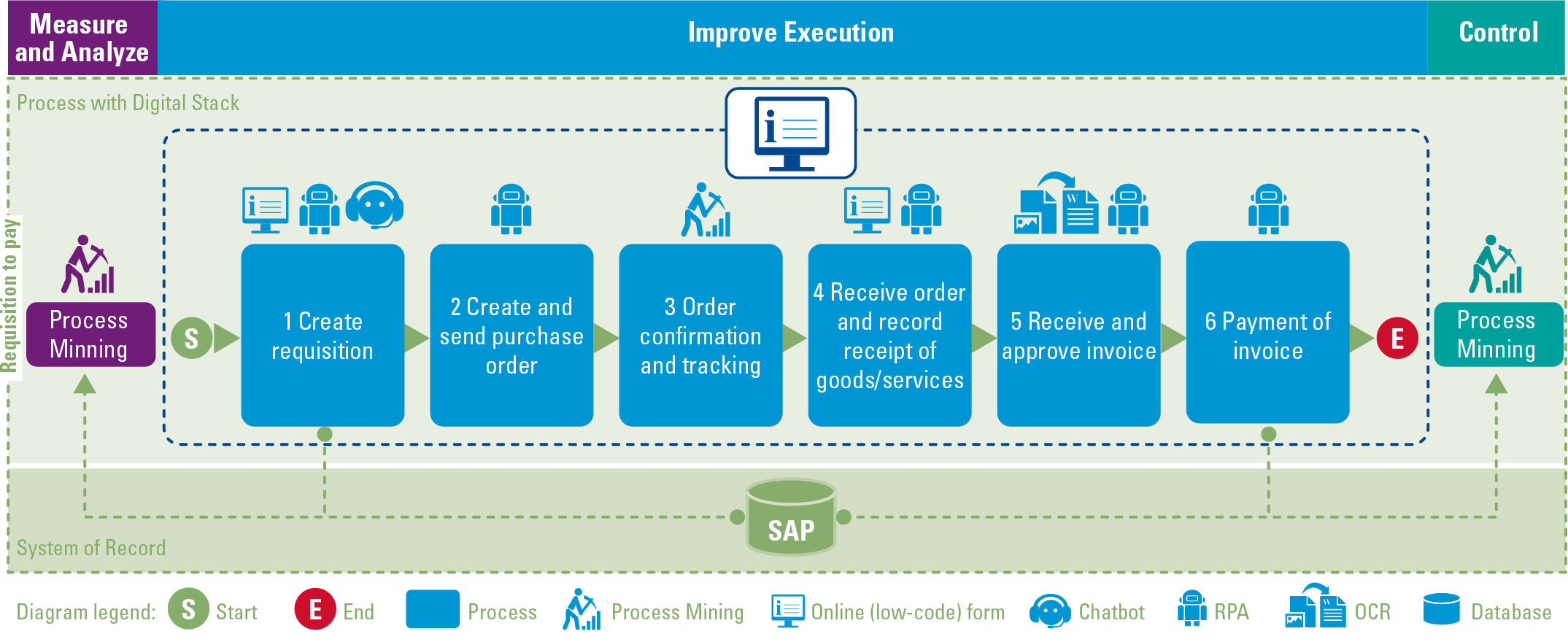Digitalization of business processes is key in creating a sustainable competitive advantage for organizations in a changing technological environment. However, in order to realize this, organizations face the challenge to digitalize processes from end to end (E2E) while simultaneously running their business. This publication discusses the positive implications of expanding the Digital Stack as a solution to this challenge.
The status quo
Organizations are traditionally set up in different functional silos, with their own goals and objectives, which together form the backbone of an organization. Domains like Sales, Finance, HR and IT all support an organization in conducting their business, but tend to be confined to their own departmental silo. This results in insufficient cooperation between the silos and little overall E2E process control in many organizations, despite the transformations towards (Global) Shared Service Centre set-ups in some. Any efforts to digitalize the organization tend to focus on efforts within the specific departments, rather than following the E2E processes that flow through multiple silos. As a result, organizations are confronted with a heavily customized IT landscape, which requires specialized knowledge to maintain, often drawing from the same scarce pool of tech-savvy resources. Meanwhile, increasingly more demanding internal and external customer relationships cause these customized “solutions” to be unable to keep up with the rate of change required to support the organization’s ability to evolve and grow.
Organizations are starting to recognize the shortcomings of their decentralized approach. In order to stay competitive, organizations face the challenge of modernizing their business processes and foster cross-functional collaboration on the one hand, while on the other hand they face scarce knowledgeable resources to speed up the transformation. The organizations that integrate their processes from an E2E perspective, are better at interacting with their internal and external customers. Next, the organizations that make tooling available to departments that require less technical skills can increase their agility, since they are using a larger pool of development capacity. Both types of organizations require the different functional domains to interact across processes and work towards realizing common organizational goals. Digitalization efforts should therefore focus on processes across using common tool platforms, rather than bespoke tooling within the organizational silos.
Introducing the Digital Stack strategy
To support cross functional digitalization and collaboration, both the existing and new tooling need to be aligned with each other in a Digital Stack. Currently, this often raises issues as each domain has its own applications or because the organization uses heavily customized and complex Enterprise Resource Planning (ERP) systems that cannot fully support the needs in every domain, according to research ([Dekk19]). Developing a strategy around adaptation of new technologies in the Digital Stack (see below) will enable a more uniform approach for E2E processes digitalization in the organization. Defining a clear strategy around the different levels (1 to 6) of the Digital Stack allows organizations to play into a number of trends we identified in the new digital reality when transforming from an on premise to a cloud environment. These trends are:
- ERPs (Systems of Record) are being stripped down, becoming smaller and more standardized.
- Data platforms across multiple applications are being developed alongside ERP for flexibility in reporting.
- More and more applications for ERP end up in we enabled portals or CRM platforms.
- Customization in the existing ERP is often replaced by new technologies from the Digital Stack (during the cloud migration).
As a result, organizations start to back away from heavily customized ERP systems. No longer does one ERP system try to fulfill all the requirements of the different domains, but each domain has a fit-for- purpose System of Record. A System of Record is an information storage and retrieval system that can serve as the authoritative source of truth, helping organizations get a handle on the overwhelming amounts of data that characterize modern working life. Having a fit-for-purpose System of Record for each domain results in better support from the IT backbone for each domain, but also reduces the need for customization and maintenance by third parties in these complex ERP systems ([Dekk19]). The advantage is that the ERP is “out of the box” and easier to maintain, but this does raise the issue of integrating the multiple systems within an organization.
The solution is to utilize new technologies that are different from the aforementioned technologies, to integrate applications across processes. The technologies within a Digital Stack help integrate your processes in your existing IT landscape to support a better end-to-end (E2E) process execution. The different (ERP) systems are just used as a Systems of Record, while other technologies within the Digital Stack enable cross-functional cooperation and process control. Any specific requirements of the domains that cannot be met by the ERP/Systems of Record will be configured within other layers of the Digital Stack, enabling a higher rate of change and easier configuration due to its low-code nature.
Options within a Digital Stack
In today’s fast-changing environment customers are better informed, better connected and more demanding than ever before. As a result, organizations are increasingly demanding software solutions that help connect different domains within their organization to create an E2E process approach. Most organizations already have an existing ERP system, but in order to help them create a more integrated process, an organization can choose between several new technology solutions that could be used for different types of process communication and/or integration. See Figure 1. for an explanation on the additional technologies in the Digital Stack.
Figure 1. Digital stack technologies. [Click on the image for a larger image]
1 System of Record (Cloud) ERP & EPM
For organizations to be innovative, they must secure their foundation by making sure every part of the organization has a stable System of Record. Although Systems of Record have been around for decades, the scope of such a system is getting smaller in the new cloud set up. A decade ago, the typical System of Record existed as a software solution in which many functions were bundled. Nowadays, the System of Record is more specialized toward specific functional needs. The most common Systems of Record are ERP suites supported by Enterprise Performance Management (EPM) tooling, but lately CRM and competing platforms are gaining momentum.
To help optimize the return on their cloud transformation investment, organizations should seek and maintain an ERP environment that integrates and optimizes both business processes and technology. This helps them to realize process & control efficiencies, cost reductions, and effective compliance management. One way to get there faster, is to make use of a specific approach when optimizing the existing ERP/EPM systems or when transferring these towards a cloud environment. There are multiple vendors offering an approach that combines implementation experience, leading practices for IT and Risk, and provides an “outcome-focused” approach for transformation. This kind of approach comprises a combination of pre-built solution assets, delivery assets & tools and a delivery method for faster, lower-risk implementation of the solution and acceleration of benefits. Using such an approach, 80% of the solution for your organization is already formed through the completion of best practices, whereas 20% is customized to your organization specific needs using tooling in the Digital Stack.
2 Process-specific solutions
Service providers such as KPMG leverage various process-specific software solutions to optimize and automate specific E2E processes of its clients, such as Order to Cash (O2C), Record-to-Report (R2R) and Purchase-to-Pay (P2P). This is being done by working closely together with software vendors such as Esker, Coupa and Tagetik. These process specific solutions manifest the optimal combinations of new technologies for only one single type of E2E process, but still work with the more generic process automation solutions in one of the other layers of the Digital Stack.
For example, KPMG’s collaboration with Esker enables clients to significantly reduce any manual work in the P2P process. By implementing automation solutions like these, accounts payable departments are able to make significant efficiency gains, making use of the latest Artificial Intelligence technologies, without having to invest in mastering these technologies themselves. The efficiency gains translated into lower operational costs, fewer supply chain disruptions and better cash flow management. In addition, implementing software solutions enabled invoices to be paid faster. Which in turn enabled better relationships with suppliers and resulted in higher (early payment) discounts.
3 Process & data mining
With today’s increasingly complex systems, tracking down operational inefficiencies and business risks is a complicated and overwhelming task. Process mining is a data-driven technology for a thorough analysis of cross-functional process chains based on unlocking process meta data held in various systems of record. The process mining technology uses the meta data to provide detailed process transparency and offers insights into the different routes a process takes. Process mining visualizes the process. For example, the process steps “create order”, “confirm order” and “approve order” are all visualized in a process flow in the order of occurrence based on the data retrieved from the systems of record. The difference between process mining and data mining, is that data mining is focused on data patterns in general, whereas process mining is relevant for business processes and their flows.
Process mining helps firms to identify process discrepancies and even suggest quantifiable process improvements. Hence offering an opportunity for organizations to embed control throughout systems and processes to reduce process costs, mitigate risk, strengthen customer relationships, and safeguard security across the entire organization.
Process mining can be used to analyze a wide range of processes from the back- and mid-office to the customer decision making processes. The tooling provides the flexibility to be leveraged in various use case areas, hence replacing some of the tedious and inaccurate analysis work done by more traditional process analysis techniques used before.
4 Low-code platforms & workflow management
Low-code is an approach for swift software development that requires little to no coding experience for building applications and digital processes, hence the name. Low-code platforms use visual interfaces with simple logic and drag-and-drop features, instead of using complex coding languages. The tools are intuitive and allow users with no formal knowledge of coding or software development to create process and case management applications, while maintaining the data integrity of underlying systems of record.
Low-code technology offers a solution to organizations struggling with their legacy systems, as they are often no longer compatible with the latest technologies and are no longer easy to update. To process data from legacy systems and transfer this data to new systems is a complex, time-consuming and costly process. Low-code platforms provide swift solutions by emphasizing the use of (visual) modeling tools to realize new business functionalities, while visualizing the underlying software code. It increases the speed of software development to support E2E processes and shortens the time to market. That is why workflow automation can easily be supported by using low-code platforms, which makes case management and managing the workflow in ever-changing working environments much simpler.
When organizations carefully design their Digital Stack according to architectural principles, good governance and practical guidelines, with a small number of software suppliers, they can leverage a variety of trends that accelerate successful transformation towards the new digital reality.
5 Robotic Process Automation
Robotic Process Automation (RPA) is a continuum of innovative technologies used to automate processes and operations that are traditionally carried out by humans. RPA often uses software robots to execute processes and operations. This type of automation is most applicable to high-volume, rule-based processes, where the steps a human would take to execute the specific processes can easily be replicated. The software robot interacts with the existing user interface – just like a human would. This means that there is no need to modify the underlying systems to automate the processes. Because of its ease of implementation, it proves to be a natural first step in many automation transformations delivering both cost and quality improvements, due to the speed and consistency of the robot.
Processes fit for RPA are those that are digitalized, standardized, rule-based and most importantly repetitive. For RPA to be successful, it is key to take into consideration that the correct execution of the individual process steps can be done without the need for human judgment and evaluation. Many examples of these processes can be found in the back-office, such as payroll, sales orders, invoice processing, etc.
6 Chatbots & machine learning
People have become used to navigating through and interacting with digital user interfaces to look for answers to their questions. However, for some complex inquiries it feels more natural to call or text for support. Intelligent chat/voicebots can automate text and voice interactions by answering questions or providing extra information if requested. Intelligent chat/voicebots have enormous potential in a variety of use cases, as an alternative to the graphical user interface, email, text messages and telephone calls. The bots can direct users in multi-intent interactions and reduce complexity, since they can just ask for what they need, instead of navigating a complex interface. Intelligent chat/voicebots can mimic human interaction, making it feel personal and tailored to the specific individual. They are easy to scale when required, reducing cost and improving overall consistency of service quality.
Machine learning is a subset of general Artificial Intelligence research, which is concerned with computer algorithms that continuously improve performance when exposed to more data over time. This means that computers can learn from experiences, just like humans do. A common occurrence of machine learning is often found in the shape of Optical Character Recognition (OCR), in which the technology is designed for optical recognition and digitization of an organization’s paper document flow. Machine learning can also be applied to other Digital Stack technologies, such as chat/voicebots. Optimization is then delivered by learning from previous interactions making them smarter over time.
Mastering these six layers of the Digital Stack will help organizations speed up their digitalization journey while maintaining end-to-end process control across the functional pillars of the organization. By providing the right applications for each of the levels of the Digital Stack, organizations provide their employees with the toolbox to master their future. Organizations need to choose between leading service providers on each of the levels that fit their digitalization strategy (see Figure 2).
Some organizations will continue to follow a do-it-for-me strategy; relying on their own IT pillar and third parties to help transform their organizations towards true digital end-to-end process management. However, many more organizations are now able to embrace a do-it-yourself strategy, allowing their employees to start improving and digitalizing their own processes, using their process knowledge and a combination of the tools in the Digital Stack of their organization. Either strategy requires organizations to make conscious choices and make sure that all of the levels of the Digital Stack are covered by at least one option in order to be successful going forward.
Figure 2. Example of vendors offering solutions in the digital stack. [Click on the image for a larger image]
Use Case: How to leverage the Digital Stack and optimize business processes?
Business processes can be optimized by leveraging the Digital Stack. An example of such an optimized process is P2P. The P2P process consists of process steps such as: requisitioning, purchasing, receiving, invoice processing and payment. To show the value of the Digital Stack, we will go through the P2P process step by step and show examples of how the tools from different levels of the Digital Stack could be deployed in this specific process. For visualization see Figure 3.
Figure 3. Example of digital stack deployment in P2P process. [Click on the image for a larger image]
Steps in the P2P process including Digital Stack opportunities:
- Create requisition. This is the first step of the requisition to pay process. An employee makes a purchase requisition, and the purchase requisition needs to be approved.
How to gain value from Digital Stack:- Low-code app & RPA: Employees fill in their purchase requisition in a low-code webform. After the requestor filled in the form, the approver receives a notification request to approve the purchase requisition. After approval, the complete and approved purchase requisition goes to procurement. In this way the low-code app works as a case management system. With RPA, the final purchase requisition is automatically filled out in the procurement system (i.e., ERP system).
- Chatbot: A chatbot could serve as a “personal virtual buying assistant” to help identify the right products, create/autofill purchase requisitions, seek approvals, or provide status information.
- Create and send purchase order. The purchase order is created and sent to the vendor.
How to gain value from the Digital Stack:- RPA: automation in the order management process. For example, order entry processes, including order taking, customer credit checking, stock checking to fulfill orders, replenishment automation and automated pricing calculations.
- Order confirmation and tracking. The order is confirmed by the vendor. At the same time, the order confirmation is being checked and compared to the purchase order. Also, the delivery of the order is being monitored.
How to gain value from the Digital Stack:- Process mining & RPA: with process mining it is possible to monitor delivery securely and identify patterns in the delivery confirmations. Delivery confirmations that are later than requested will be identified and it is possible to automatically act on this information (i.e., updating the planning or informing the team).
- Receive order and record receipt of goods/services. The order has arrived at the designated destination and the receipt of goods is logged into the procurement system.
How to gain value from the Digital Stack:- Low-code & RPA: Employees fill in their receipt of goods in the low-code app. With RPA the receipt of goods is automatically registered in the ERP system.
- Receive and approve invoice. The invoice of the order is received and a check of conformity between purchase order, receipt and invoice is fulfilled.
How to gain value from the Digital Stack:- OCR & RPA: With RPA it is possible to automate manual actions in the “receive and approve invoice” process step, such as receiving, booking and exporting information to the procurement system. Combine RPA with OCR to recognize and process unstructured invoice data. RPA could, subsequently, capture invoice data and interact with major invoice formats to index, separate, validate & classify invoices based on the vendor.
- Payment of invoice. The invoice is being paid.
How to gain value from the Digital Stack:- RPA: RPA controls whether the invoice is paid, allocates the money received and closes the order.
Difficulties in selecting the right vendor
Selecting the right vendor(s) for the layers of the Digital Stack is now more difficult than (ever) before for the following reasons:
- Vendors try to keep their position safe. Vendors that first provided a solution for only one of the layers in the Digital Stack are adding more and more functionalities to products, for example low-code vendors which now also offer robotic process automation. In this way, the boundaries between the layers of the Digital Stack are starting to fade away.
- Large IT vendors discovered the Digital Stack. The large IT vendors also discovered the Digital Stack and are currently developing all kinds of products within their own label in order to maintain market share. This complicates the discussion. The advantage of large IT providers is the alleged integration and development power. However, that does not mean these large IT providers are at the forefront of each layer of the Digital Stack. These parties keep playing catch-up in certain tooling with industry leaders.
- Marketing talks versus use cases. Understanding the Digital Stack means looking beyond the marketing talk of vendors, or what vendors are developing (so-called “vaporware”). Rely on proven use cases, preferably based on your own specific process situation, instead of marketing presentations. Trust in results realized by other organizations rather than unproven papers or talks. This takes time, so be critical of what you read or hear.
Lessons learned of implementing the Digital Stack
- Start with one technology. Start with RPA or process mining and expand to low-code and chatbots to teach the organization how to deal with new technology and learn to develop by themself.
- Taking ownership of digitalization. From experience we can say that new technologies can do anything but taking people along in the journey to take ownership for their own digitalization is the biggest challenge.
- Think about governance. Digitalizing the organization becomes a success if you follow this strategy, but governance can become challenging. Digitalizing can spiral out of control which can result in multiple incidents if there is no clear governance structure in place after the initial pilot successes.
- Do not underestimate the security aspect. One point of attention that is often underestimated in the selection process is that all layers in the Digital Stack have security aspects and in case of (sensitive) personal data, also privacy aspects. We did not cover the security aspects in this article; however, this does not imply that tools in the Digital Stack neglect security nor cover all your specific security requirements out-of-the-box.
- Take your organization’s digital capacities into account. Some tooling (depending on the vendor) can only be developed or managed by IT-savvy employees, while other tooling is open to be used by non-IT people (e.g., functional experts). Make sure to align your Digital Stack strategy towards your digital capacities.
Build your own Digital Stack
What to consider when building your own Digital Stack?
In order to address your organization’s situation properly, some considerations are important before jumping into an actual implementation. Some examples:
- Is there a desire to move from a functional organization to a process-driven organization, in which agile working in the business is supported?
When process-driven thinking is well developed within your organization, your organization can more easily implement the Digital Stack, which leads to cross-functional process improvements. Through the Digital Stack, you give process owners room to promote collaboration across departments. - To what extent is the current brownfield situation critically examined or is there scope for a greenfield approach?
Many IT organizations stick to a brownfield setup, which is just regularly updated without looking critically at the current brownfield situation or without a clear vision of the target operating model. - Is the organization aimed towards point-to-point process solutions with a focus on quick wins or do you want to focus on a cloud/platform idea with room for internal development?
A proper construction of the Digital Stack requires time and involvement of, in many cases, non-IT people of process/functional areas, which is not always available/given. - How do we ensure that the Systems of Record (ERP), related to the cloud solutions, really remain “standard”?
In other words, how much room do we want to leave for customization in the Systems of Record at the base?
Opting for new technology in the Digital Stack is a strategic choice that moves away from third-party customization and is based on your own agile way of working with your own people. It is a top-down (tone at the top) choice that must be made and carried out to succeed. - What is the role of a “data platform” to prevent customization in the ERP layer?
A clear data strategy is essential for successfully applying new technology, with the focus on developing data cubes outside the systems of record. - Does the organization strategy allow for a do-it-yourself approach by their employees or is the focus on do-it-for-me by external parties?
As mentioned earlier, implementing the Digital Stack depends on your organization’s strategy and IT capacities. - To what extent do you want to further develop people in the organization with digital resource development & training and what does that mean for your retention rates?
Employees in processes are ultimately the key to success for digitalization. Make sure to create room to take people on the journey. Your people eventually determine speed and success.
Conclusion
In conclusion, the Digital Stack helps in overcoming the challenges organizations face when digitalizing processes end-to-end, while at the same time, they continue to run their business as usual due to their agility. The technologies within the Digital Stack enable domains within organizations to better grasp growth opportunities by gearing from a decentralized approach to a cross-functional collaborative way of working. When organizations carefully design their Digital Stack according to architectural principles, good governance and practical guidelines, with a small number of software suppliers, they can leverage a variety of trends that accelerate successful transformation towards the new digital reality.
Reference
[Dekk19] Dekker, M. et al. (2019). Robotics Process Automation: address functional and technical challenges during SAP implementation projects with RPA. Compact, 2019(1). Retrieved from: https://www.compact.nl/articles/robotics-process-automation/







